As we originally outlined last year, while plans for a 24-unit development to rise up to 40 feet in height along Diamond Street, on the hillside overlooking Noe Valley, between the intersection of Diamond Heights Boulevard and 29th Street, were in the works, San Francisco’s Planning Department was pushing for more density on the site, estimating that “roughly 43 units could be reasonably provided on the site under the base zoning,” highlighting, at least briefly, that the project as proposed was one (1) unit short of the 25-unit threshold which would require a higher percentage of inclusionary housing to be built.
And with Planning having requested that the team explore “all available options that [would] maximize residential development on the site,” and “strongly encouraging” the team to increase the density of the proposed project prior to submitting a formal application to proceed, a comparative massing for a 43-unit development was drafted by SCB and rendered for full effect.
With the massing in hand, the project team subsequently submitted its formal application to proceed with the 24-unit development as newly rendered below, with 20 three-bedroom, roughly 1,950-square-foot, townhomes in 10 duplex structures and 4 four-bedroom single-family homes averaging closer to 3,400 square feet apiece and a total of 36 off-street parking spaces (which is up from 24 as originally proposed).
And with all that in mind, the plans for the proposed 24-unit development could be approved by San Francisco’s Planning Commission at the end of this month, which would require the Commission to approve a Conditional Use Authorization (CUA) for the development, acknowledging that the project “does not maximize the principally permitted residential density of the subject lot,” while approving requested exceptions to the lot area, front setback and rear yard requirements of San Francisco’s Planning Code as well.
We’ll keep you posted and plugged-in.
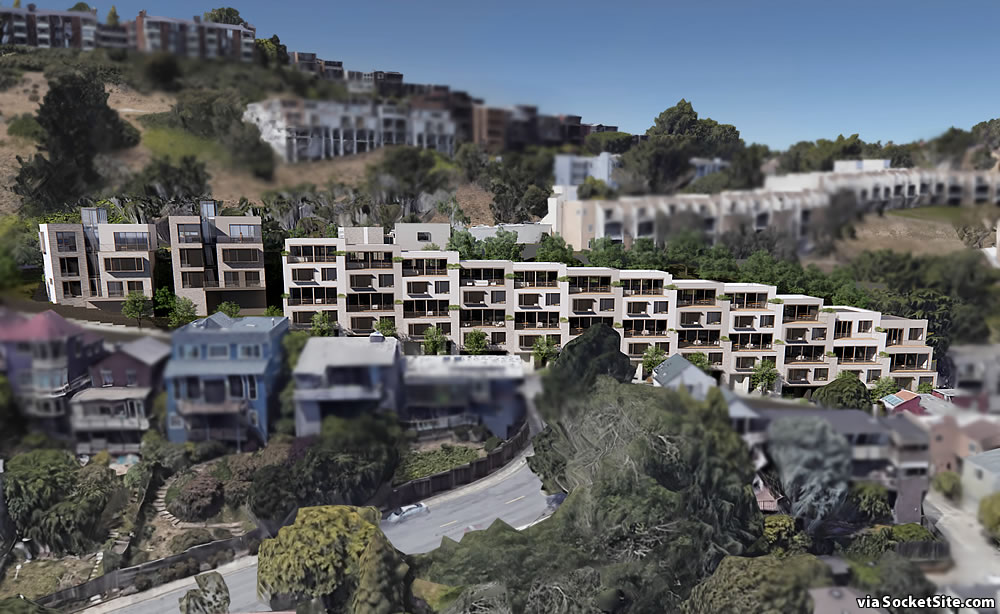
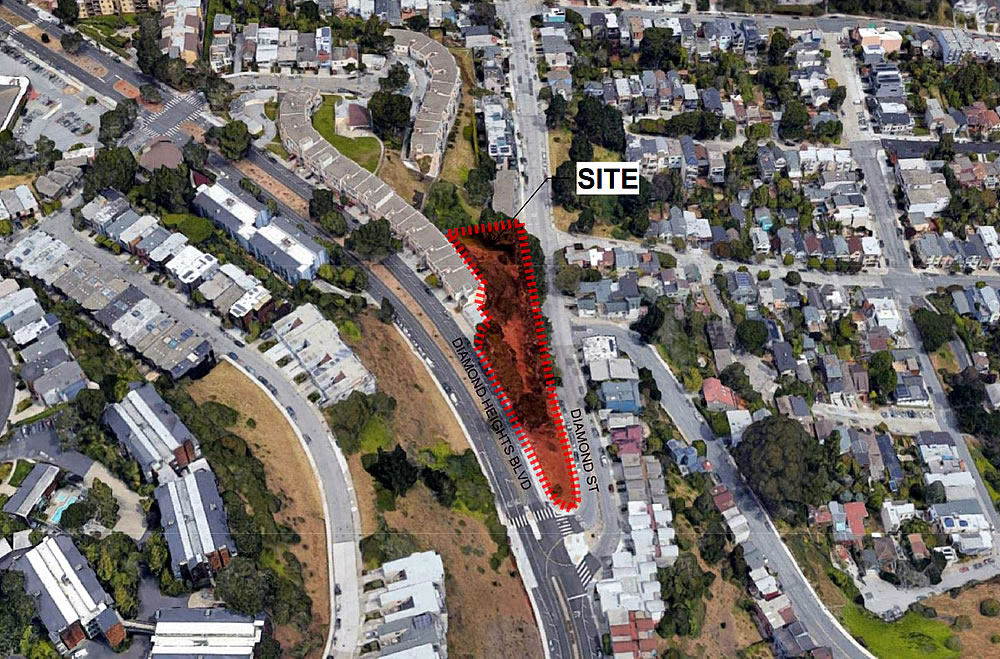

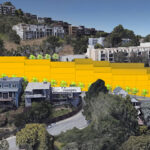
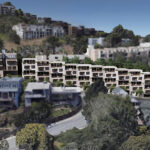
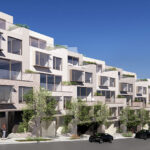
I’ll let the music do the talking for me (even if they’re maybe “big boxes on the hillside…’)
I know some people think that song is cute, but in retrospect it’s pretty gross to hear a cutesy song being this cynical about the basic human need for housing. It’s the generation that experienced the cheapest housing in American history getting caught up on the fact that most homes are rectangles. Maybe they should write a song about how the homeless should just get more creative if they want housing!
Tony, you have a really, really good point. (Not being sarcastic.)
It’s not about the shape of the homes. It’s about suburban sprawl and becoming a uniform, conformist society. You should read the lyrics.
That’s not the way it’s used on here^. Songs take on lives of their own. Look at “Born in the USA,” 95% of the people who love that song have no idea what it’s really about.
Perhaps the song can be interpreted on a number of levels: both superficially on the monotony of the houses themselves and more archly as a comment on who lives in them.
I was aware of the duality and debated whether to post this, but since SF’s (alleged) loss of personality is still an issue – probably far more now than in 1962, actually – I decided to go ahead; but if many never get past the first point, it’s no shame.
There’s no way you really believe that song is about architecture
That said, get the trucks rolling and get em built
Yes and no, the song is mostly about expressing unhappiness at the highly conformist culture of the time. It’s that feeling when you look at society and you don’t see a place for yourself in it, instead you see a machine that lacks personality. That feeling is called alienation, and many of the criticisms of society it spurs are valid and deserving of discussion. However, alienation just like cynicism has a dark side that can often hinder people from finding solutions to the very problems creating the alienation.
When the average person looks at a new apartment building being built and complains that it has “no character” they’re not really making commentary on architecture. They’re expressing dissatisfaction over the fact they do not see their lives and efforts being part of the society living in that housing, and instead see it as the mundane result of a faceless machine. A well functioning society listens to its people and accepts criticism constructively, but if people don’t have the self awareness to manage their feelings of alienation appropriately it can devolve into self-defeating cynicism.
What I’m getting at is that the kinds of NIMBYs that hate every new apartment building they see and post “Little Boxes” really do care a lot about housing and people’s wellbeing, and we need them as a society to be part of discourse, but ultimately no single victory on housing policy or design can heal one’s sense of alienation. This becomes a problem when you have large home-owning/rent controlled population enjoying stability later in life (objectively a good thing) that still feels alienation against a problematic economic system (a legitimate complaint), but is insulated from the material harm done to younger generations by saying “no” to pretty much all housing.
Tl;dr the usage of “Little Boxes” in housing discussion sounds more like teenage angst than legitimate care about the necessities we all depend on for survival. Thank you for coming to my TED talk.
Damn good mic drop!
Am I missing something? Planning requested “Please increase the number of units”, and then the developer came back with exactly the same number of units, each larger than originally planned. There’s no increase in density, just an increase in unit size.
This. Too few units. Also, too much parking, and parking should be unbundled since we KNOW that forcing buyers/renters to pay for parking whether they want it or not just leads to more car purchases, pollution, VMT, and congestion, and a harder time supporting frequent Muni service.
YES!!! Build it now. It’s equidistant walking distance between the Glen Park Bart station, the Diamond Hts Shopping Center and Noe Valley. And yes there is Muni service to bring you back up the hill.
I would have built on Diamond Heights and gone down-slope on at least part of the lot…
It’s a travesty if the Planning Commission lets this go forward as 24 (instead of 25+) units. We need more housing, we need more affordable housing, and this proposal is falling short on both.
Naah bra’, everyone’s going to Tahoe. Build it there. San Francisco is a sinking ship.
Wow. In what possible universe is this anything but cramming cruddy boxes on a hill already too crammed with cruddy boxes? And can we just all agree that “much needed housing” has gone the way of all massively overused, thoughtless, stupefying, conversation shutting-downing drivel – which is to say don’t say it. Its like saying “people need shoes!” in a conversation about cowboy boots.
I do wonder about the long term, more broad consequences of encouraging/facilitating population growth in an earthquake threatened state with an increasingly serious water problem?
Far more the latter than the former. The Romans managed to import water – quite well, I’ve heard – but it seems to elude us.
But if makes anyone feel better, agriculture is the big user … even under Doomsday scenarios there’s more than enough H2O for the peeps, but mourn for that almond tree you adopted online.
Right, and there’s still plenty of low hanging fruit to optimize water usage in cities, mainly by switching to drought tolerant landscaping and limiting potable water usage to human and animal consumption. Recycled water can be used for other usage like irrigation and toilets. The lavender pipes are expanding.
Even agriculture has a lot of room for improvement. Most farmers in the Central Valley receive water allocations determined decades ago that were based on inefficient farming techniques and thirsty crops. They sometimes “dump” water to avoid having their historic allocations trimmed back.
UPDATE: Modified Plans for Prime Hillside Site Slated for Approval